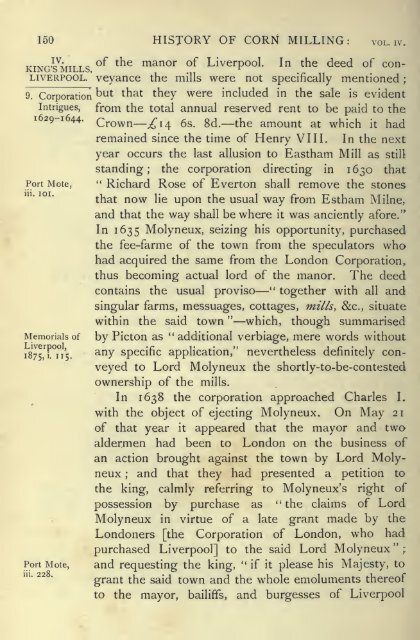History of corn milling .. - Centrostudirpinia.it
History of corn milling .. - Centrostudirpinia.it
History of corn milling .. - Centrostudirpinia.it
Create successful ePaper yourself
Turn your PDF publications into a flip-book with our unique Google optimized e-Paper software.
150 HISTORY OF CORN MILLING: vol. iv.<br />
IV.<br />
KING'S MILLS,<br />
LIVERPOOL.<br />
9. Corporation<br />
Intrigues,<br />
1629-1644.<br />
Port Mote,<br />
iii. Id.<br />
Memorials <strong>of</strong><br />
Liverpool,<br />
1875, i. 115-<br />
Port Mote,<br />
iii. 228.<br />
<strong>of</strong> the manor <strong>of</strong> Liverpool. In the deed <strong>of</strong> con-<br />
veyance the mills were not specifically mentioned ;<br />
but that they were included in the sale is evident<br />
from the total annual reserved rent to be paid to the<br />
Crown— ^14 6s. 8d.— the amount at which <strong>it</strong> had<br />
remained since the time <strong>of</strong> Henry VIII. In the next<br />
year<br />
occurs the last allusion to Eastham Mill as still<br />
standing; the corporation directing in 1630 that<br />
''<br />
Richard Rose <strong>of</strong> Everton shall remove the stones<br />
that now lie upon the usual way from Estham Milne,<br />
and that the way shall be where <strong>it</strong> was anciently afore."<br />
In 1635 Molyneux, seizing his opportun<strong>it</strong>y, purchased<br />
the fee-farme <strong>of</strong> the town from the speculators who<br />
had acquired the same from the London Corporation,,<br />
thus becoming actual lord <strong>of</strong> the manor. The deed<br />
contains the usual proviso — " together w<strong>it</strong>h all and<br />
singular farms, messuages, cottages, mz//s, &c., s<strong>it</strong>uate<br />
w<strong>it</strong>hin the said town "— which, though summarised<br />
by Picton as ''add<strong>it</strong>ional verbiage, mere words w<strong>it</strong>hout<br />
any specific application," nevertheless defin<strong>it</strong>ely conveyed<br />
to Lord Molyneux the shortly-to-be-contested<br />
ownership <strong>of</strong> the mills.<br />
In 1638 the corporation approached Charles L<br />
w<strong>it</strong>h the object <strong>of</strong> ejecting Molyneux. On May 21<br />
<strong>of</strong> that year <strong>it</strong> appeared that the mayor and two<br />
aldermen had been to London on the business <strong>of</strong><br />
an action brought against the town by Lord Molyneux<br />
; and that they had presented a pet<strong>it</strong>ion to<br />
the king, calmly referring to Molyneux's right <strong>of</strong><br />
possession by purchase as ''the claims <strong>of</strong> Lord<br />
Molyneux in virtue <strong>of</strong> a late grant made by the<br />
Londoners [the Corporation <strong>of</strong> London, who had<br />
purchased Liverpool] to the said Lord Molyneux";<br />
and requesting the king, "if <strong>it</strong> please his Majesty, to<br />
grant<br />
the said town and the whole emoluments there<strong>of</strong><br />
to the mayor, bailiffs, and burgesses <strong>of</strong> Liverpool

















